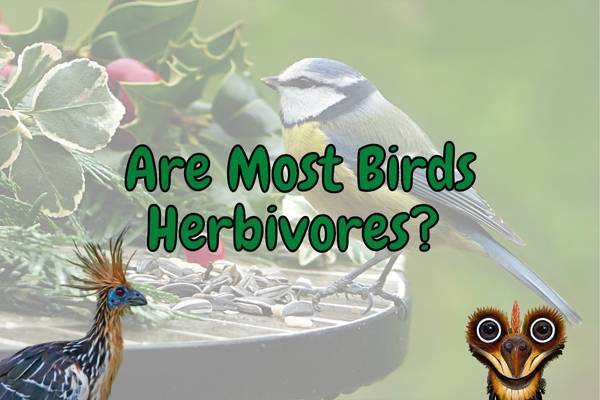Birds are diverse creatures that eat a variety of things. The majority of birds are actually herbivores, which means that they primarily eat plants supplemented with a few insects, but most birds will eat what is most readily available to them.
Most birds are omnivores and they typically eat various things, including fruits, vegetables, seeds, nuts, and insects.
Some birds, however, like hawks, eagles and vultures are purely carnivores and eat mostly meat as their digestive system does not tolerate plants well.
In fact, only 2% of bird species eat a diet consisting of more than 95% plants! These include the hoatzin of the amazon rainforest and certain waterfowl.
Different bird species have different diets depending on what is available to them in their environment. For example, finches primarily eat seeds while parrots enjoy eating fruit, and birds of prey are pure carnivores.
The diet of a bird also depends on its size. Smaller birds tend to eat more seeds and insects since they require more protein to maintain their body weight. But larger birds may have an easier time overwhelming other animals, so they can be primarily carnivores.
Contents
Most Birds are Herbivores!
Almost all birds, with the exception of the predatory types, are herbivores to some extent, yes!
So most birds’ diets consist largely of vegetable matter, although a few species, the flamingos, or crows, for example, can be almost entirely carnivorous if needed.
Most birds consume their vegetable food in the form of seeds, fruit, and other plant parts, but the great majority of them feed chiefly on the seeds, leaves, buds, and flowers of plants.
Birds that feed on insects may do so extensively, as, for example, those that eat locusts, grasshoppers, or caterpillars as their main diet, or they may prefer insects but will take an occasional plant, fruit, or seed when the opportunity arises. These omnivorous but mainly carnivorous birds include the Jays and the crows that are largely omnivorous.
Many birds, such as sparrows, feed mainly on grains, berries, and nuts but their exact diet depends on their habitat and the season of the year. As such, the animal content of their diet varies throughout the year.
Many birds eat more fruit in autumn and more insects when available in the spring and summer. And some birds that do not naturally eat a lot of animals in their diet, have become much more opportunistic in their dietary preferences after human cities started to emerge.
For example, birds like pigeons and seagulls only became truly omnivores when they became adapted to human settlements, where they will eat whatever, animal or plant, that is available to them. This ability to consume a broad diet is now part of their immense success!
A broad diet makes birds important to the ecosystem
Birds are important for the ecosystem for a variety of reasons. As omnivores, they help to control populations of other animals by eating them, and as herbivores they help to spread seeds and pollinate flowers.
The presence of certain bird species is therefore also an indication of environmental health!
Birds play an important role in controlling populations of for example insects by eating them. This helps to keep the population of the insects, but also the other animals eating the insects in check and prevents them from becoming too abundant.

This is important because if one species becomes too abundant, it can upset the balance of the ecosystem and lead to problems such as disease outbreaks or habitat destruction.
Birds also help to spread seeds and pollinate flowers. By doing this, they help to ensure that plants can continue to grow and thrive. However, some birds also eat the actual flowers, which, ironically can also help the pollination of the flowers that survive!
This is important because plants are a vital part of the ecosystem and provide food and shelter for many other animals.
Finally, birds can be indicators of environmental health. Because they are so sensitive to changes in their environment, they can be used to monitor pollution levels or other factors that may be adversely affecting the ecosystem.
Are All Birds Either Carnivores, Herbivores, or Omnivores?
The terms carnivore and omnivore as applied to birds are often misunderstood. Many bird watchers and ornithologists use carnivore and omnivore in a very broad sense for the entire class Aves, and this is where the confusion arises.
Carnivores and herbivores in this case refer to animals that eat mostly meat or mostly eat plants, respectively. However, many species of bird are difficult to categorize, as many are facultative carnivores and omnivores and very few eat plants exclusively.
Very few birds are pure herbivores because they will almost always eat an insect or two or some other animals. For example, most geese and swans do not want to eat other animals, but they do so unintentionally when eating from the water where thousands of microscopic animals (zooplankton) is found!
In fact, only 2% of bird species have a diet mostly consisting of plants, and even fewer are purely vegetarian!
One bird that is a true herbivore is the hoatzin bird of the Amazon rainforest. The hoatzin is a South American bird that is only found in the Amazonian rainforest. Its diet consists of leaves, flowers, and fruit but no animals at all!
The hoatzin has a long neck and legs, and it can grow to be about two feet tall and 2lbs heavy.
Its wings are short and rounded, and it does rarely fly but it lives high up in the trees, usually near rivers, so that predators cannot get to them!
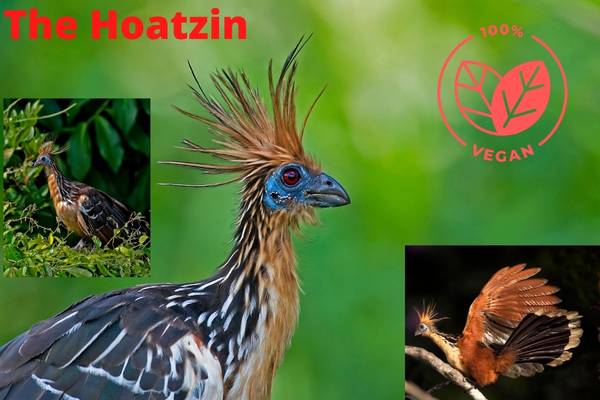
They have a strong smell that is produced by bacteria in their gut. These bacteria are important for their digestion and are the main reason that they are able to survive on leaves alone.
The hoatzin is a bit like the proboscis monkey or a cow in that it can survive on plants alone via fermentation of the plant material into the proteins and fats that they need to grow!
Examples of mostly herbivorous birds are:
- Geese (especially the Snow Goose and Nene Goose)
- Grebes
- Swans
- Emus
- Takahe
- Kakapo
- Lorikeets
- Most parrots
- sage-grouse
These birds, especially the waterfowl, will accidentally eat small animals like zooplankton, when they sieve through the water for plants and algae, so they are not strictly herbivorous.
You might wonder: why are hummingbirds not on this list as they eat nectar? But in fact, no bird can live exclusively on nectar as it lacks some vital proteins, fats, and vitamins for the bird to grow!
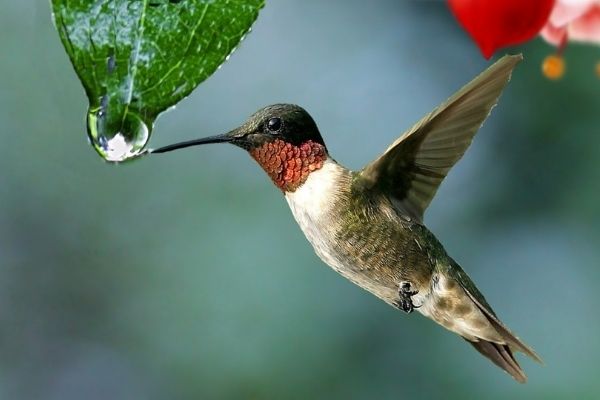
So even though they may seem to eat nectar all the time, they do indeed snap an insect out of the air once in a while!
Examples of omnivorous birds:
- Pigeons
- Crows and ravens
- Jays (such as the blue jay)
- Blackbirds
- Starlings
- Flamingos
- Sparrows
The list is in fact much longer as most birds are in reality omnivorous, but these are some of the most “balanced” omnivores eating almost equal ratios of plants and animals.
Other birds may occasionally ingest plants, but aim to eat a purely carnivorous diet.
Pigeons:
Pigeons, scientifically known as Columba livia, are medium-sized birds belonging to the family Columbidae. They are widely distributed across the globe, inhabiting both urban and rural environments. Pigeons have a compact and robust body, with a length of about 30 to 35 centimeters and a weight of around 300 to 400 grams.
Omnivorous by nature, pigeons have a diverse diet that includes both plant and animal matter. They primarily feed on seeds, grains, fruits, and berries, which make up a significant portion of their diet. In urban areas, they scavenge for food scraps and crumbs, often relying on human-provided sources such as bread crumbs or bird feeders. Pigeons also consume small insects, worms, and other invertebrates, especially during breeding season when they require higher protein intake.
These birds have a unique digestive system that allows them to utilize a wide range of food sources. They possess a muscular crop, an enlargement of the esophagus, which aids in storing and softening food before digestion. Pigeons also produce a substance called “pigeon milk” in their crop, which is a specialized secretion that they feed to their young.
Crows and Ravens:
Crows and ravens are highly intelligent birds belonging to the family Corvidae. They are known for their adaptability and problem-solving abilities. While they share several similarities, ravens are generally larger than crows, with a wingspan of up to 1.3 meters and a weight of around 1 kilogram.
Both crows and ravens are opportunistic omnivores, displaying a varied and adaptable diet. They consume a wide range of food items, including fruits, seeds, nuts, grains, and invertebrates like insects, worms, and snails. They are also known to scavenge and feed on carrion, making them valuable in natural ecosystems as they help clean up dead animals.
These birds are highly skilled at foraging and have been observed using tools to access food. They can also remember the locations of their food caches and find hidden or buried food items. Crows and ravens are known to be attracted to human settlements and garbage dumps, where they can find additional food resources.
Jays (such as the blue jay):
Jays, particularly the blue jay (Cyanocitta cristata), are colorful and medium-sized birds found in North America. Blue jays have distinct blue feathers on their upper body, white or pale gray underparts, and a crest on their head. They are known for their raucous calls and bold behavior.
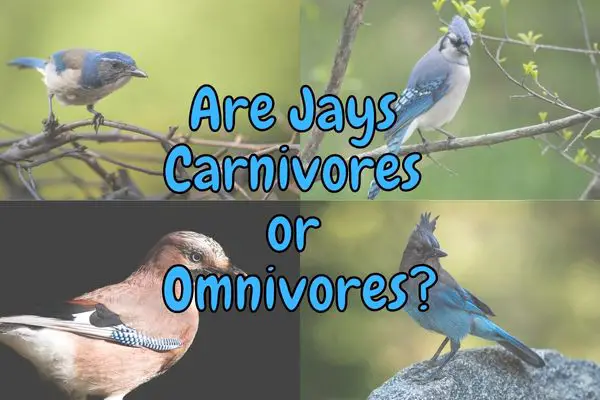
Jays are opportunistic omnivores with a diverse diet. They feed on a variety of plant material, including nuts, seeds, acorns, and berries. Insects, caterpillars, and spiders also form an essential part of their diet, especially during the breeding season when they require more protein to raise their young. Jays are known to hoard food, collecting and storing excess food items in various locations to be consumed later.
Their beaks are strong and well-adapted for cracking open nuts and seeds. Jays are also known to feed on eggs and nestlings of other birds on occasion. In addition to their foraging skills, blue jays are known to mimic the calls of other bird species, sometimes using this ability to deceive or communicate with other birds.
Blackbirds:
The term “blackbird” is used to refer to several bird species belonging to the family Icteridae, including species like the common blackbird (Turdus merula) and red-winged blackbird (Agelaius phoeniceus).
Despite their name, many blackbird species are not entirely black. The common blackbird, for example, has black feathers but displays a vibrant yellow eye-ring and a distinctive orange beak. Red-winged blackbirds, on the other hand, have black feathers with red and yellow shoulder patches in males, while females have streaked brown plumage.
Blackbirds are omnivorous birds with a varied diet. They forage primarily on the ground, probing the soil with their beaks to find insects, earthworms, snails, and other small invertebrates. They also feed on a range of fruits, berries, seeds, and grains. Blackbirds are known to visit gardens and orchards, where they can feed on fruits and crops.
During the breeding season, blackbirds become territorial and defend their nesting areas. They construct cup-shaped nests in trees or shrubs, using grass, twigs, and mud. The female blackbird lays a clutch of eggs, usually 3 to 5, and both parents take turns incubating the eggs. Once the chicks hatch, the parents continue to provide them with a varied diet of insects, spiders, and soft fruits.
Starlings:
Starlings are medium-sized birds belonging to the family Sturnidae. The most well-known species is the European starling (Sturnus vulgaris), but there are other species found in different parts of the world. Starlings have a sleek and iridescent plumage, which is dark with a metallic sheen. In flight, their wings display striking white spots or bars.
Starlings are highly adaptable omnivores and have thrived in various environments, including urban, suburban, and rural areas. They have a diverse diet that consists of both plant and animal matter. They feed on a wide range of fruits, berries, seeds, and grains. In urban areas, they often exploit food resources such as garbage bins or bird feeders. Starlings are also skilled insect hunters, catching insects on the ground or in mid-air.
These birds are known for their remarkable vocal abilities and complex songs. They are capable of mimicking sounds and songs of other bird species, as well as imitating human noises and even car alarms. Starlings often form large flocks, especially during the non-breeding season, creating mesmerizing aerial displays known as murmurations.
Flamingos:
Flamingos are iconic birds known for their unique appearance and distinctive feeding habits. There are several species of flamingos, but the most well-known is the greater flamingo (Phoenicopterus roseus). They have long legs, a curved neck, and a vibrant pink plumage, which is a result of their diet.
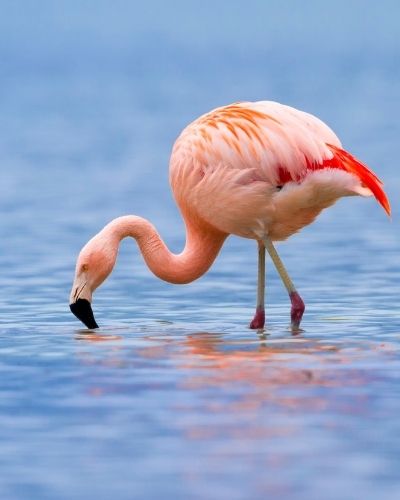
Flamingos are filter-feeding omnivores, specialized in consuming small organisms found in water. They inhabit saline or alkaline lakes, lagoons, and coastal mudflats. Using their specialized bills, flamingos filter water and mud to extract small crustaceans, mollusks, algae, and insects. Their bills have a unique structure that allows them to expel excess water while retaining the tiny food particles with bristle-like structures.
To facilitate their feeding, flamingos wade in shallow water, often standing on one leg for extended periods of time. This posture not only conserves energy but also reduces their exposure to predators. The pink coloration of their feathers comes from pigments obtained from the organisms they consume.
Flamingos are highly social birds, often found in large colonies that can consist of thousands of individuals. They engage in synchronized feeding, moving together in a line or a circular motion to stir up food from the water. These colonies provide protection against predators and facilitate courtship and breeding behaviors.
Sparrows:
Sparrows are small, chunky birds belonging to the family Passeridae. There are many species of sparrows found worldwide, and they are known for their adaptability and widespread distribution. While their appearance may vary slightly between species, sparrows generally have short, stout beaks, rounded bodies, and brown or gray plumage with streaks or patterns.
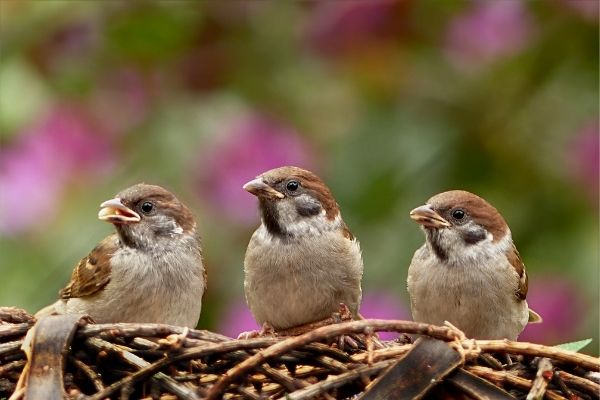
Sparrows are opportunistic omnivores with a diverse diet that varies depending on their habitat and food availability. They primarily feed on seeds, grains, and small fruits, making use of their beaks to crack open seed casings. They are often seen foraging on the ground, searching for fallen seeds or insects in grassy areas or agricultural fields.
In addition to plant material, sparrows also consume insects, spiders, and other small invertebrates. During the breeding season, protein-rich food sources become crucial for sparrows as they need to provide adequate nutrition to their offspring. They catch insects in mid-air or glean them from vegetation, exhibiting agile flight and quick movements.
Sparrows are highly adaptable and have successfully integrated into urban environments. They are commonly found around human settlements, where they take advantage of food sources such as bird feeders, crumbs, and discarded food. Sparrows are known for their communal roosting behavior, gathering in large numbers to rest and sleep together, providing safety in numbers.
These birds are also known for their chirping and melodious songs, which they use for communication and territorial displays. Sparrows form monogamous pairs during the breeding season and build cup-shaped nests in various locations, including trees, shrubs, or even human-made structures. Both male and female sparrows take part in nest construction and rearing of the hatchlings.
Some carnivorous birds are:
- Eagles
- Ospreys
- Falcons
- Owls
- Hawks
- Vultures
- Herons
- Storks
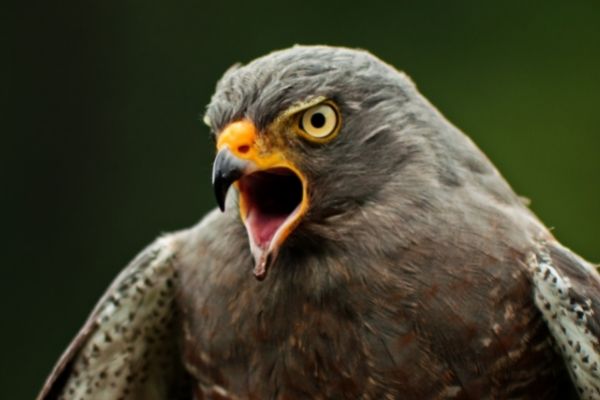
Are Birds Producers, Consumers, or Decomposers?
All animals can technically be considered consumers, as they need to consume their energy from plants or other animals.
The herbivorous birds described above are considered primary consumers, whereas omnivorous birds can be both primary and secondary consumers.
Those on the last list are purely carnivorous and are therefore considered tertiary or quaternary consumers (apex predators).
Birds occupy various niches in ecosystems worldwide, playing important roles as both predators and scavengers.
When we examine the feeding habits of birds, we find that the majority of species are heterotrophs that rely on consuming other organisms for energy. These organisms can range from insects and seeds to small mammals and fish, depending on the species and its ecological niche. Birds employ a wide array of feeding strategies, including herbivory, carnivory, and omnivory, showcasing their adaptability in utilizing available food resources.
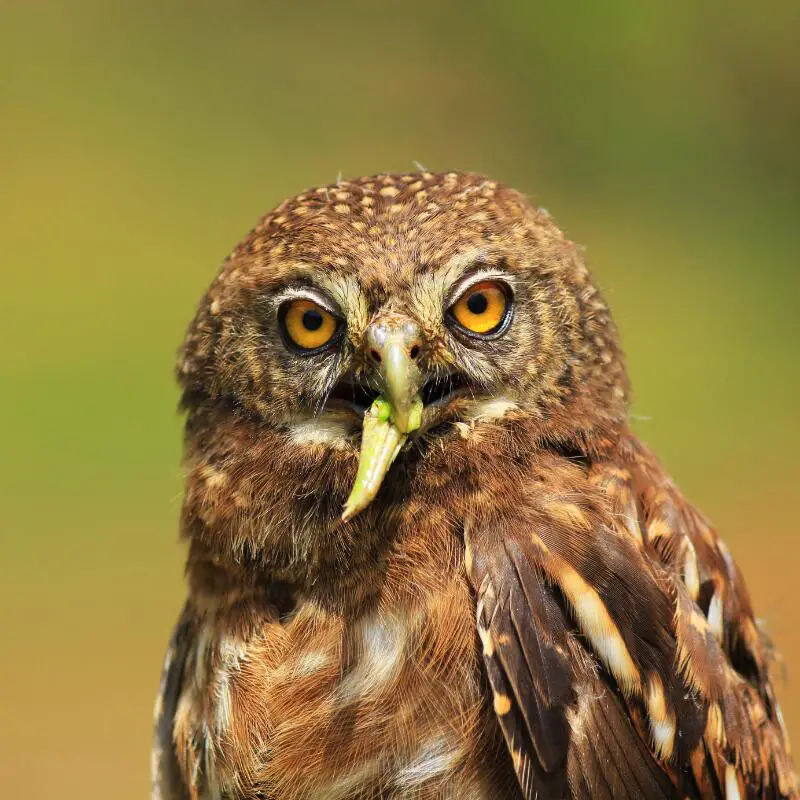
Personally, I have spent countless hours observing and studying bird behavior in different habitats. I vividly remember the sight of raptors soaring high above me, their sharp eyes scanning the landscape for prey.
Their hunting techniques and the precise moment they strike are a testament to their consumptive nature as top predators in many ecosystems.
While it is true that some birds, particularly certain species of vultures and scavenger birds, may exhibit decomposer-like behaviors by feeding on carrion, it is important to note that this behavior does not define their ecological role as a whole.
In my fieldwork, I have come across scenes of vultures gathering around carcasses, their bald heads providing an evolutionary adaptation to prevent bacteria from festering in their feathers. It was a fascinating sight, but it is not representative of the broader feeding habits of all bird species.
On the other hand, birds do contribute to nutrient cycling and energy flow within ecosystems through their role as consumers. As they consume prey, whether it be insects, small mammals, or plant material, birds metabolize the nutrients from their food, converting them into energy for their own growth, reproduction, and survival. During my research on migratory birds, I observed how they rely on abundant food sources in specific regions to fuel their long-distance journeys, emphasizing the energetic importance of their consumer role.
Moreover, birds also contribute to seed dispersal and pollination, acting as vital agents for plant reproduction. When birds consume fruits or nectar, they inadvertently transport seeds or pollen to different locations as they move and excrete waste.
This process enables plant species to colonize new areas and maintain genetic diversity within populations. I have witnessed this ecological interaction firsthand while studying the intricate relationship between birds and flowering plants in tropical rainforests.
Their role in dispersing seeds contributes to the maintenance of biodiversity and the overall health of these ecosystems.
In conclusion, birds are primarily consumers in the food chain, utilizing a diverse range of feeding strategies to meet their nutritional requirements. While some species may exhibit decomposer-like behaviors in specific contexts, this behavior does not define their ecological role as a whole.
Birds play crucial roles in energy flow, nutrient cycling, and ecological interactions such as seed dispersal and pollination.
Their presence and behavior contribute to the complexity and balance of ecosystems worldwide. As a biologist, my experiences and observations have only deepened my appreciation for the important role birds play as consumers, and I continue to be fascinated by their diverse adaptations and ecological contributions.
Where are birds in the Food Chain?
Birds are in the middle of the food chain and most are secondary or primary consumers. Herbivorous birds are exclusively primary consumers, and many omnivorous birds belong mostly to this category as well.
But whereas they mostly eat plants, seeds and berries they do also eat the insects that live in plants or worms they find in the ground. Therefore most birds also act as secondary consumers.
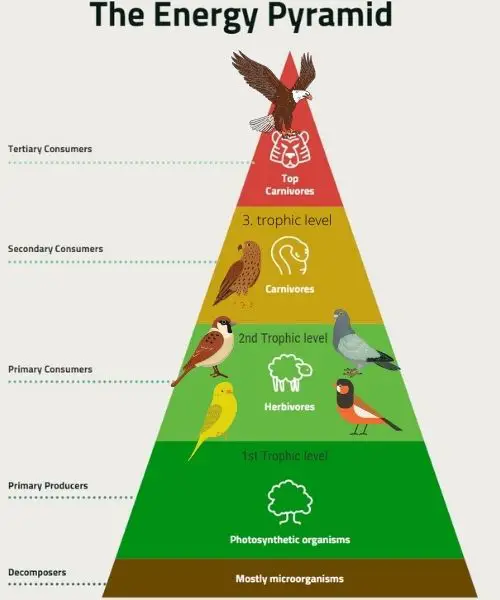
Plant eating birds are heterotrophs because they obtain energy from the food they eat rather than using sunlight for energy as some bacteria, algae, and plants do. This means that they channel energy up through the food chain into, the much less energy-efficient, carnivores.
Birds may also use other animals such as insects or fish for energy, which classifies them as facultative carnivores. However, most species of birds are exclusively herbivores, as they eat only plants for food.
As a biologist with a deep understanding of food chains and ecosystems, I can confidently say that birds occupy a crucial position in various food chains around the world.
Birds can be found at different trophic levels, depending on their feeding habits and ecological niche. Some birds are primary consumers, while others act as secondary consumers or even tertiary consumers. Their role in the food chain is vital for maintaining the balance and functioning of ecosystems.
Let’s begin by examining the position of birds as primary consumers in the food chain. Many bird species, such as finches, sparrows, and pigeons, primarily feed on seeds, fruits, nectar, and plant material.
They play an essential role in seed dispersal and pollination, aiding in the reproduction and dispersal of plant species. When birds consume fruits or seeds, they may inadvertently drop or excrete some undigested seeds in different locations, allowing for the colonization of new areas by plants. This process contributes to the diversity and distribution of plant species within an ecosystem.
Moving up the food chain, we find birds that occupy the role of secondary consumers. These birds primarily feed on insects, spiders, worms, and other small invertebrates. For example, insectivorous birds like warblers and flycatchers are known for their adeptness in capturing insects on the wing.
By preying on invertebrates, birds help control their populations, preventing outbreaks or imbalances that could occur if insect populations were left unchecked. This ecological service provided by birds helps maintain the overall health and stability of ecosystems.
Additionally, some birds occupy the role of tertiary consumers, also known as top predators in the food chain. Birds of prey, such as eagles, hawks, and owls, are excellent examples of tertiary consumers. They feed on a variety of organisms, including smaller birds, rodents, fish, and even reptiles.
These birds play a crucial role in regulating the populations of their prey species, ensuring the balance within the ecosystem. Without the presence of these top predators, lower trophic levels could experience population explosions, leading to cascading effects throughout the food chain.
It is worth noting that birds can occupy multiple trophic levels within the same ecosystem, depending on their dietary flexibility. Some species may exhibit a more opportunistic feeding behavior, adapting to the availability of resources. For example, seagulls are known for their ability to scavenge for food, consuming both marine organisms and discarded human waste. This adaptability allows birds to occupy different positions in the food chain, playing diverse roles in the ecosystem.
Moreover, birds can also serve as important indicators of environmental health. Changes in bird populations, such as declines or disappearances, can signify imbalances or disturbances within an ecosystem.
Scientists and conservationists often monitor bird populations as a measure of overall ecosystem health.
For instance, the sudden disappearance of certain bird species may indicate the presence of pollutants or habitat degradation. By studying the abundance and diversity of bird species, researchers can gain insights into the overall state of an ecosystem and take appropriate conservation actions.
In conclusion, birds occupy crucial positions within food chains, acting as primary consumers, secondary consumers, and even tertiary consumers. Their feeding habits, ranging from seed dispersal to predation, contribute to the functioning and balance of ecosystems. Birds play a significant role in controlling populations of insects and other invertebrates, aiding in pollination and seed dispersal, and serving as top predators. Their adaptability and ecological contributions make them valuable indicators of environmental health. As a biologist with personal experiences studying birds in the field, I am continually fascinated by their intricate roles in the complex tapestry of life.
What Eats Birds?
Birds are eaten by mammals, reptiles, amphibians, fish, some insects, and other birds.
The birds that are herbivores are usually also less defensive than those that are predators and birds of prey, such as hawks, eagles, and owls will also hunt and kill smaller birds.

Mammals such as foxes, cats raccoons, and opossums will sometimes eat bird eggs, but birds like magpies, crows, and jays will also do so.
Birds have evolved different strategies to avoid predators. Some species will form flocks and take turns sleeping and standing watch.
Others will roost in trees with dense foliage that makes it difficult for predators to approach. Still, others will nest in cavities or on ledges where they can see approaching predators.
Birds also have a variety of vocalizations they use to warn other birds of danger and in addition to being alert to the presence of predators; many birds will also try to camouflage themselves or their nests by building them to blend in with the surroundings.
Conclusion
Birds can be both herbivores, omnivores and carnivores. The majority of birds are actually herbivores, which means that they primarily eat plants. Some birds, however, are carnivores and eat mostly meat.
Some birds may even act as cannibals that kill their own offspring!
Different bird species have different diets depending on what is available to them in their environment, but most birds are primarily herbivorous and will eat various things, including fruits, vegetables, seeds, nuts, but also insects.
For example, finches primarily eat seeds while parrots enjoy eating fruit and do not seek out animal food very often.
Almost all birds, with the exception of the predatory types, are herbivores to some extent. Their diet consists largely of vegetable matter, although a few species, the flamingos, for example, are partially carnivorous but eat mostly algae.
Birds are important for the ecosystem for a variety of reasons. As omnivores, they help to control populations of other animals by eating them, and as herbivores, they help to spread seeds and pollinate flowers. The presence of certain bird species is therefore also an indication of environmental health!

